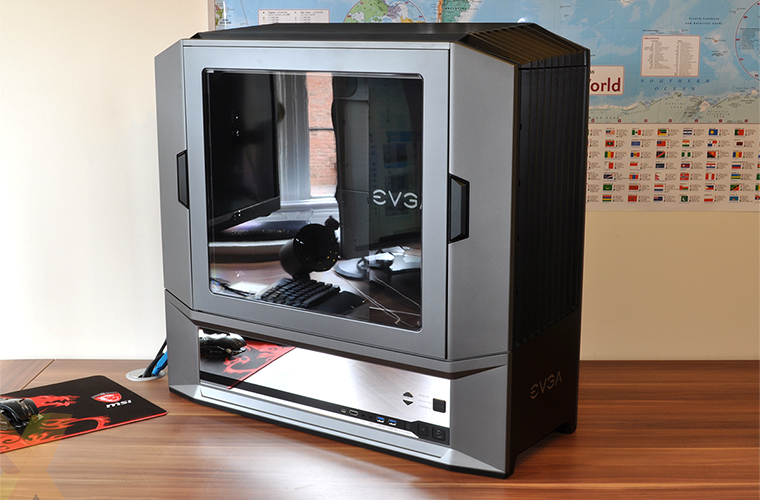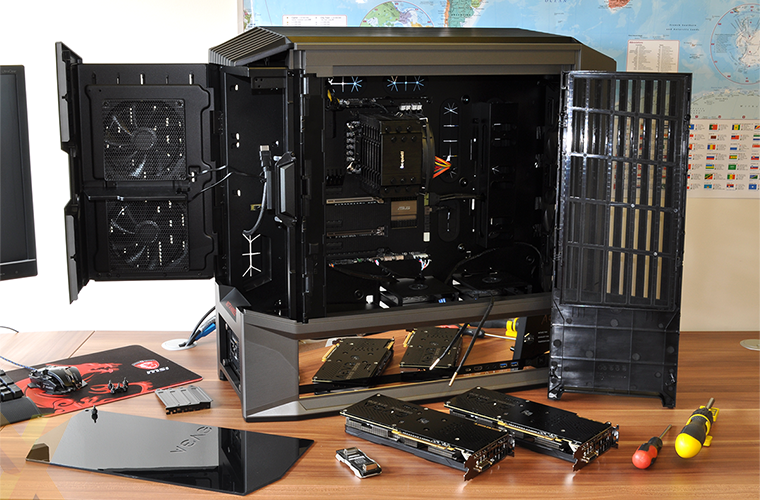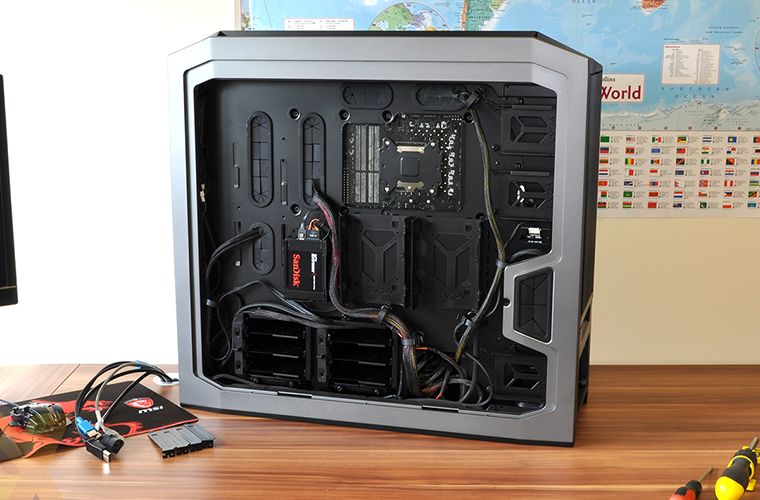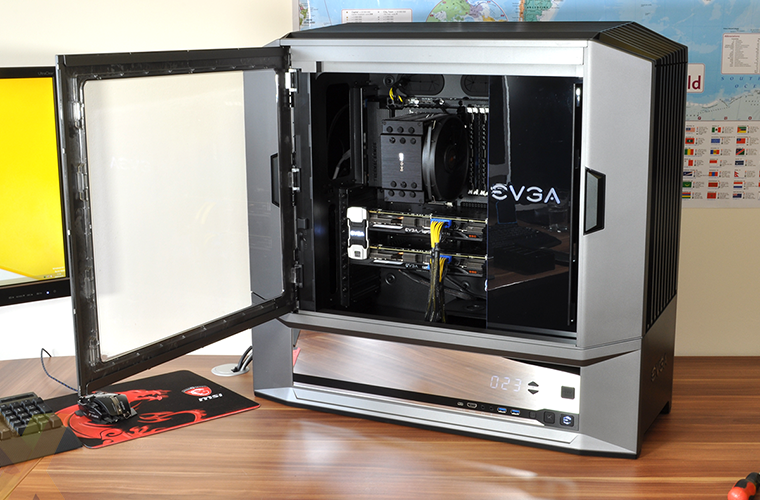Building with DG-87
Before we get into the nitty-gritty details, we should remind readers that our review sample is a pre-production unit. EVGA is keen to stress that "the appearance, look and features are representative of the final production case," but adds a proviso in that "several items will be improved for the final production case."
What exactly the improvements will be is anybody's guess, however we imagine any changes would be related primarily to fit and finish. The majority of the panels on our review chassis line up very well, however the front door doesn't always sit flush when closed, the power supply had to be forced inside rather than sliding in smoothly, and on first boot we found that the mesh grill on one of the rear exhausts would catch the fan blades. These are signs of a hand-tooled sample and we presume alignment will be perfected for the retail product.
You've seen the press shots and we can confirm that DG-87 looks every bit as imposing in the real world. We happened to have an In Win 909-based Cyberpower Luxe Xtreme in the labs when DG-87 arrived, and though the In Win chassis can be considered big, it looked surprisingly insignificant when put alongside the hulking EVGA.
One thing the stock photos don't convey is how reflective the strip near the bottom of the chassis actually is. It's a proper mirror, reflecting everything around it, and the effect actually works really well. We were worried the mirror would come across as garish, but those fears can be laid to rest. If anything, the reflection helps DG-87 blend into its surroundings.
So how do you go about getting inside? Well, the chassis has two doors; the large front window; and the plastic shroud on the left. Both are opened by pressing the push-to-release black buttons on either side and note that neither door is reversible - they swing from right to left. Getting into the main cavern couldn't be easier, and to help ease the build process, the windowed door can be lifted clean off its hinges using a convenient sliding release switch on the inside.
Start to open it up and it becomes clear that DG-87 can't easily be stripped down in the way most other enclosures can. The mirrored panel on the bottom portion isn't designed to come off and neither is the rear door. Users who are willing could of course tear down the majority of the panels, but we suspect the case has been designed this way to keep some of the internal cabling hidden from view. There's plenty going on in terms of I/O ports, yet you see hardly any of the associated wires during the build process.
One component that does come out quickly is the black Perspex panel that is used to cover the right-hand quarter of the internal void. The screen is quite handy if you shan't be installing anything in that area, but there is a dedicated reservoir mount to the right of the motherboard tray. Should a reservoir be installed, we imagine the Perspex would be removed for the liquid-cooling hardware to be visible, and it's a straightforward process - just a single thumbscrew needs to be undone for the panel to come away. Modders will no doubt be eyeing up this panel for other reasons.
Getting the motherboard installed is simple due to raised standoffs and there are plenty of well-sized and rubber-grommeted cable holes above and to the side. Dust filters include a small mesh section that pulls out from underneath the PSU bay and mesh lining on the back of the push-to-release front panel. So far so good and EVGA adds to the DG-87's appeal with a series of unexpected tweaks. The nine expansion slots, for example, are covered solely by the individual brackets so that you can take them off to leave a large gap for airflow or liquid-cooling tubes. Another nice touch is the slidable tray above the PSU - it can be used to hide power cables and is one of many simple-but-effective additions.
There's plenty of room around back for cable management, which in our estimation is one of DG-87's biggest strengths. It's very easy to create a clean-looking build, and EVGA's circular cable ties are excellent. Attached to the back of the motherboard tray at various points, the plastic hoops are able to swivel to suit your preferred routing path and they also unclip to open, making it easy to put cables in. The only potential stumbling block in the cabling department is that the front-panel connectors are a little on the short side - they just about reached the headers on our Asus Sabertooth motherboard, but we suspect other boards won't be as forgiving.
Storage, as pictured above, is handled exclusively from the back of the case. There are two drive cages attached to the floor of the enclosure, and each is equipped with three metal trays capable of supporting a 2.5in or 3.5in drive. What's neat is that the trays are held in place using a tool-free securing lever - simply slide it down to free all three trays. Both cages can be removed if deemed surplus to requirements, and you'll still have the six plastic trays fixed to the back of the motherboard panel - two are sized for 3.5in drives, while the other four allow for tool-free installation of SSDs.
As for cooling, DG-87 comes with half-a-dozen 140mm fans installed as standard; two exhausts on the left; a single exhaust up top; plus three front intakes. All six are hooked-up to the built-in fan controller, so you only need to attach a molex connector to your PSU, but do note that there's also a SATA power connector for the internal lighting and LED display. EVGA doesn't (yet) produce any liquid coolers of its own, however the case is prepared for dual 420mm or 360mm radiators. Ample scope for a high-end setup, though we do wonder if the large sections on the left and right will be detrimental to cooling performance. As it stands, any installed graphics cards will be roughly 15cm from the back of the case, which isn't necessarily ideal for coolers designed to expel hot air through their I/O plate.
Putting together our test platform was stress-free, and if you don't mind us saying so, we reckon our Z77, dual GTX 970 build looks looks pretty smart. And that's part of the DG-87's appeal - it can make a high-end PC appear very expensive without the need for any costly mods. If you're still trying to get a better sense of scale, that little thing to the left of the chassis is a 28in Philips 4K monitor.
It's a beast alright, yet it has a certain charm about it and the LCD temperature display is another very nice touch. The white backlight is subtle enough not to be disturbing (as indeed is the very slight illumination inside the case), and the internal temperature probe is at the end of a reasonably long cable, allowing for a position of your choice. You can't use the display to show CPU or GPU core temp, but get the probe close enough and you'll have a good idea.
In addition to temperature, the display can also be used to show fan speed percentage. Hitting the 'mode' button will cycle between probe temp, exhaust fan speed and intake fan speed, and when set to either of the latter modes the up and down arrows can be used to adjust fan speed in five per cent intervals. Turning it down to zero will turn the fans off entirely. Last but not least, the K-Boost button can be used to switch fans to high speed, and if you choose to install EVGA's optional DG Tuner software utility, it will also toggle between user-defined Windows power plans.













